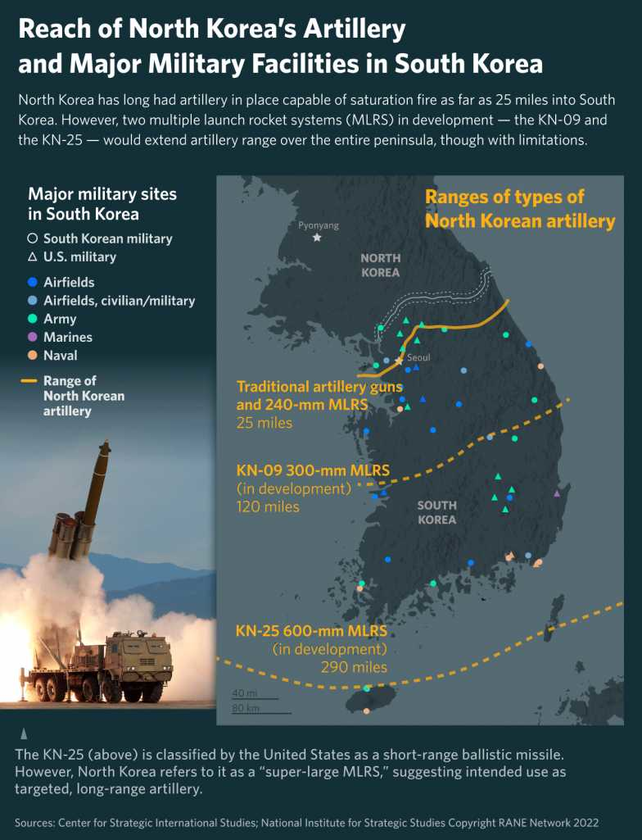Over the past few years, North Korea has focused on advancements in short-range tactical systems, including maneuverable short-range ballistic missiles, cruise missiles, large-caliber rockets and hypersonic glide vehicles. While some of these systems could technically carry nuclear warheads, they appear to be conventional systems, intended to counter U.S. and South Korean anti-missile systems and provide Pyongyang with tactical strike capability in South Korea. North Korea still retains its arsenal of intermediate- and long-range nuclear weapons, which the country considers a deterrent against U.S. attack. But these short-range tactical systems provide Pyongyang more ways to manage its political and security needs by enabling North Korea to increase pressure on adversaries in ways far less likely to trigger a full-scale war.
Indeed, North Korea’s more recent focus on conventional missiles and rockets appears aimed at providing Pyongyang with a calibrated escalation capability — one that may paradoxically increase the potential for limited conflict and decrease the incentive for nuclear escalation.
All-or-Nothing Deterrence
North Korea has long pursued a “poison shrimp” strategy, one that ensures that any potential opponent knows that the value of attacking you exceeds the likely cost. Since the end of the Cold War, North Korea’s primary deterrent has been the threat of a devastating response — whether through amassing conventional artillery capable of devastating the area around the South Korean capital of Seoul, or developing long-range nuclear-capable missiles capable of hitting cities along the U.S. West Coast. The basic framework of this strategy long provided enough deterrent to dissuade proactive military action from South Korea or the United States. But it also limited Pyongyang’s room to maneuver by locking it into an all-or-nothing dynamic with its opponents in which any military clash, if not immediately de-escalated, could rapidly shift from a small localized event to a full war.
North Korea simply did not have the military capability or confidence to engage in a war with its more powerful opponents and win. So Pyongyang used its frontline artillery, and later its nuclear missiles, as ways to deter any escalation from its opponents. Anything more than a small-scale proportionate response by Seoul or Washington to a North Korean military “provocation” could be seen by Pyongyang as a preemptive strike to degrade its capabilities, triggering the use-it-or-lose-it response.
This has kept North Korea safe from in-kind retaliation when it carried out an aggressive act, such as the 2010 sinking of the Cheonan or the shelling of Yeonpyeongdo. But it has also limited the country’s ability to use its military force as a tool of political coercion. If its opponents assume Pyongyang is not suicidal (as they should), they also understand North Korea cannot escalate without moving to total war — one that the North is likely to lose.
More Options for Escalation
This imbalance has, in turn, left little room for calibrated escalation or de-escalation, which North Korea now appears to be trying to address by focusing on short-range conventional systems.
Shaping tensions through calibrated escalation would enable North Korea to pursue similarly calibrated political goals. Rather than demanding all U.S. forces leave the Korean Peninsula (something it is unlikely to achieve), a calibrated escalation (and de-escalation) of tension and military action would grant Pyongyang space to focus on subcomponents of its broader goal — all while keeping the devastating war a present but not immediate threat.
In some ways, Pyongyang may be shaping this strategic shift by watching the actions of post-Soviet Russia. Moscow’s possession of nuclear weapons has constrained significant military counteractions in recent decades, but its conventional capabilities have also enabled Russia to attain targeted political (and territorial) goals along its periphery through persuasion, threats and, in some cases, even localized military action.
Imagine a scenario where North Korea wants to force a new negotiation with Seoul over access to the West Sea along the Northern Limit Line, as it did in several military actions in 1999-2010. Those previous incidents each resulted in a brief flare-up, with both Koreas rapidly backing off, and the United States providing a cautious and often late show of military might. Neither Seoul nor Washington was willing to escalate further out of concern that striking too deeply into North Korea could quickly turn a localized clash into a full war by triggering an existential fear in Pyongyang. But this also meant that North Korea’s concerns were ultimately left unaddressed, as it couldn’t engage in a calibrated escalation.
However, with its evolving tactical conventional arsenal, North Korea could now conceivably continue to escalate, step by step, without having to go for the “nuclear” option. Pyongyang could use its tactical systems to selectively and sequentially target military assets in South Korea, minimizing civilian casualties. This would slow the pace of retaliatory actions by placing the onus for further escalation on Seoul and Washington. It would also shift to a question of pain and risk tolerance, and increase the space for social and political forces to weigh in in South Korea and the United States.
Coping With a Less-Nuclear North Korea
Such added space for calibrated escalation may increase the risk of limited conflict, but it also increases the space for de-escalation. In the past, North Korea had limited room for escalation unless it wanted to risk total war. But this also meant that if pressed, Pyongyang had limited room for concessions. Pyongyang’s defense strategy locked it into a “use it or lose it” scenario if there was an escalation on the Peninsula. Its opponents were stronger, so if the North accepted a tactical strike against a key asset, it would effectively be giving up all of its options. This left a thin line between capitulation and launching an all-out response, whether through an artillery barrage on Seoul or a nuke lobbed at Los Angeles.
In the long run, North Korea’s ability to engage in calibrated escalation may also provide space for arms control negotiations. While Pyongyang will not give up its nuclear capability, its expanding conventional capabilities may provide enough confidence for Pyongyang to engage in arms control talks — accepting certain limitations on quantity or testing cycles and limited inspections of its nuclear weapons forces in return for the United States and South Korea adjusting their defense postures, lifting sanctions and granting North Korea greater access to global markets and technology.
For Washington and Seoul, North Korea’s conventional armament provides a new challenge. While it may open the country to some form of negotiations over its nuclear forces, it also gives Pyongyang greater military options on the Korean Peninsula without being “suicidal.” At the same time, it opens limited strike capabilities for the United States and South Korea against North Korea. But U.S. and South Korean military actions can be highly politically charged, and Pyongyang may be counting on the lower risk tolerance of its competitors to shape their behavior.
How to get your free month
How pricing works
How to view posts
What you can post
A #podcast about #persuasion, #deception, #communication, and the #Grayman
https://promocards.byspotify.com/share/5e3dfefd944d823be992a43447470e279711b635
These are some of my favorite camping tips A #podcast about #preparedness, #camping, #hiking, and the #Grayman
https://spotifyanchor-web.app.link/e/umedj5kJiBb
















